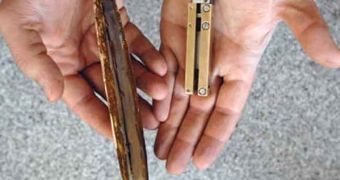As we reported recently, scientists at the Massachusetts Institute of Technology (MIT) developed a new type of anchor for small submarines and robotic sea explorers, which acts by embedding itself in the sea floor in the same way clams do. Now, it turns out that the same technology can be used to detonate underwater mines, which are either floating freely, or are buried under a thin layer of sand. The Atlantic razor clam (Ensis directus) served as inspiration for the MIT group, led by mechanical engineers Anette Hosoi and Amos Winter, LiveScience reports.
This species of clams is one of nature's best diggers, the team reports. In spite of its simple anatomy, it is able to bury itself in the beds of its native mudflats at a rate of about one centimeter per second, which means that it reaches safety from predators within a few seconds, if need be. Hosoi reveals that the way the clam goes about embedding itself in the sand is by first pushing in the material with its “foot” (mixing the sand with the liquid above), and then pushing downwards in a synchronized motion. This basic, two-step approach proved to be extremely efficient and reliable for the animals, so evolution favored it.
The new anchor designed at MIT is a very small, lightweight and energy-efficient robot, which gets its commands from a control boat. A tether holds it in place as it digs. The innovation opens and closes with the help of air pressure from a connected scuba tank nearby. This approach mimics the bivalve structure of clams closely, which is precisely what the MIT team was going for. The machine is able to function just as precisely as the real deal, and the team is currently testing it extensively in the mudflats off Cape Cod.
“The thing that surprised me most is how robust the digging mechanism is. The clam's digging strategy works equally well in sand, glass beads, cohesive soil, mud. The challenge in anchoring small underwater vehicles is that both space and power are severely limited. We set out to design an anchoring mechanism that is compact, low-power and reversible,” Hosoi reveals. Winter says that the new mechanism could potentially be used for oil-drilling as well. “There are locations in the ocean that are too deep to reach easily with remotely operated vehicles and conventional oil drilling technology,” he adds.
“In these ultra-deep water applications, we envision oil production equipment that automatically secures itself when it hits the bottom. We could use RoboClam-derived anchors to automatically affix the equipment, and automatically retract when the equipment needs to be recovered,” the expert shares.

 14 DAY TRIAL //
14 DAY TRIAL //